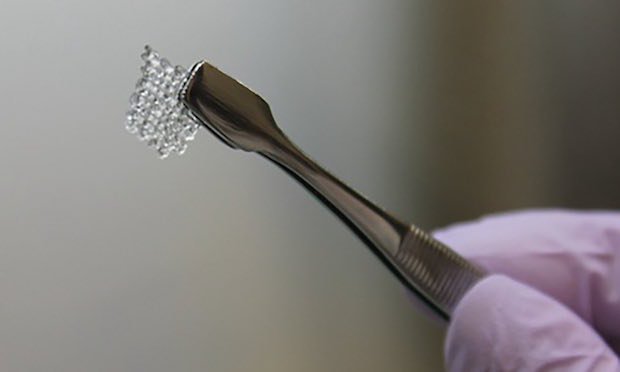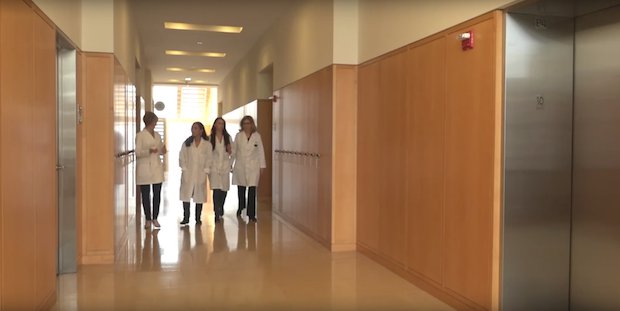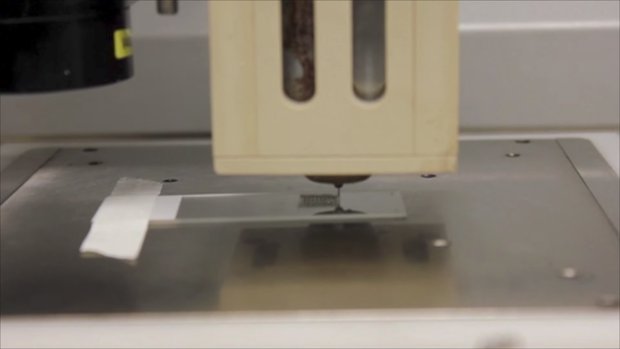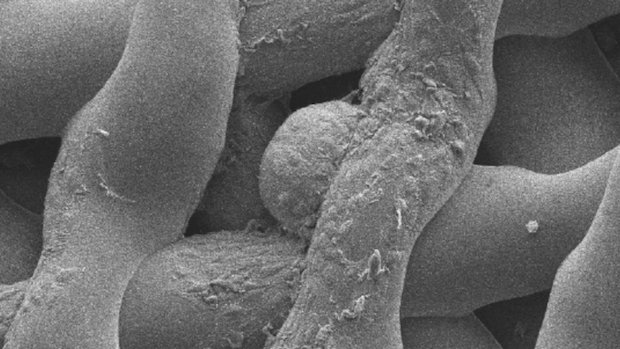
A scientist holds a scaffold for a bio-prosthetic mouse ovary 3D printed in gelatin.
Posted on 05/21/2017 4:24:09 PM PDT by null and void
The 3D printed scaffolds for ovary implants have been successfully tested on mice.

A scientist holds a scaffold for a bio-prosthetic mouse ovary 3D printed in gelatin.
Biomedical scientists from Northwestern University in Chicago are on track to develop ovary implants for humans with 3D printing technology after successfully testing 3D printed scaffolds on mice.
After three years of research and endeavour, the group recently publicised their findings, which led to three of seven mice giving birth to pups, with another generation following later. The motivation for this research centred on providing hormone functionality and fertility solutions for cancer sufferers, who have been left sterile after their treatment.
As things stand, the only option is to preserve ovarian tissue in a freezer. Previously, researchers have had some success with the transplanting of tissue back into patients when they are ready to conceive, or for their hormone functions to be restored. However, for many cancer patients this would be an unsafe procedure since their ovarian tissue contains cancerous cells.
“We wanted to engineer an ovary that would be a step forward in trying to have a way to remove the cells that we don’t want, including the cancer cells, and just put in the cells that we do want, which would be the potential egg cells, and the steroid-producing cells,” Monica Laronda PhD, a co-author on the study, told TCT. “That’s what we did with mice.”

The researchers at Northwestern University. From left to right: Monica Laronda; Ramille Shah; Alexandra Rutz; Teresa Woodruff.
Laronda and her colleagues isolated the mice’s ovarian follicle units, which contain the centralised potential egg cells surrounded by the support cells, to produce the ovarian sex hormones. Needing a way to maintain the ovarian follicle’s spherical shape, Leronda and Teresa Woodruff, Women’s Health Research Institute Director, Northwestern University, turned to Ramille Shah, an Assistant Professor, and Alexandra Rutz, a fellow in Shah’s lab. They work in a nearby laboratory and work with 3D printing technology. After a trial and error process, Rutz eventually found an architecture and structure that worked with the ovarian follicles that Laronda and Woodruff had seeded.
“After confirming that it worked with our follicles in culture, we transplanted them into mice whose ovaries we surgically removed,” explained Laronda. “We put the bio-prosthetic ovary in the same spot of where their natural ovary was an we mated them, and they were able to produce healthy pups.”

A scaffold being printed on an EnvisionTEC bioplotter
Mice are among the most used biomedical research models. Their accessibility, affordability, and genetic manipulations are all enticing to biological researchers. Yet even with the vast knowledge researchers have of mice genetics, the intervention of 3D printing was required to ensure the process went smoothly. Laronda believes the scaffolds, 3D printed with an EnvisionTEC Bioplotter, provided the sufficient support required to maintain a spherical shape. Maintaining the follicle’s natural shape is important to preserve the cell-cell connections between the oocyte and the surrounding cells, which enables cells to develop into a fertilisable egg. These eggs were then pipetted into scaffolds, and transplanted into the mice.
The scaffolds were printed in gelatin, a biological hydrogel, which brought a number of advantages. It’s a relatively cheap material, and it has been FDA-approved for other uses. Laronda outlines a third benefit - one which expands the translational capacity of the group’s research.
“Gelatin is derivative of collagen which is the most abundant structural protein in most organs, including ovaries, so it has the binding sites and the available protein structure that ovarian cells like. We predicted that our follicle would like this material,” Laronda said. “Alex Rutz devised a technique that was able to print gelatin in a very smooth, homogenous way, different to what other people have been able to do before. It provided a great scaffold for us that was able to expand its own weight, it has multiple layers, and normally when you print gelatin it collapses on itself, but she was able to do it in a way that was able to maintain those layers separately.

Microscopic look at a bio-prosthetic mouse ovary
“The great thing with 3D printing is we were able to discuss what we think would work and Alex was able to hand them to us the next day,” Laronda reflects. “We were able to try them with mouse follicle culture within days of coming up with the design, printing our ideas – within 24 hours you would be able to use it. The printing itself only takes about five minutes.”
A five-minute print time is a welcome transient compared to the rest of the project, which has taken the best part of three years. And there’s still some way to go before these 3D printed gelatin scaffolds are implanted into humans – this method would be tested in cultural models first as a safety measure, just as it was for the mice, and as it will be for the next animal model: Mini pigs.
“We’re doing the same thing in larger animal models, so we’re scaling it to see if we can restore hormone function and fertility in the same we did in mice. That is our next step” concluded Laronda. “The animal we’re using is closer with their anatomy and hormone cycles to humans than mice are, so we’re hoping well get some answers from that. We’re really excited to do that research.”
Video here
Ramille Shah, a leading researcher on the study, gave some insight into Northwestern University's research and 3D printing's growing role in healthcare at the 2017 RAPID+TCT event during a panel session on Medical 3D Printing Applications.
Pancreas printing would end diabetes.
Probably more for trannys.
Maybe they could 3D print a brain for a libtard.
This sounds like a wonderful medical technology. I’m all for it!
How soon until human clinical trials?
The Trans community will benefit greatly! </sarc>
Exactly what I thought.
Can’t those Lyme’s Disease propagating vermin just have their babies, ‘The Old Fashioned Way?’
Are we running out of disease-carrying mice? ;)

There is work being done today on that very thing.
Even some on replacement thyroids, though it’s doubtful that will bear fruit as replacement thyroid hormone pills are so cheap and effective.
I’m all for this.
Perhaps while they’re at it, they could discover a way to stop women from scraping out what current ovaries are producing.
In the US? 50 to 100 years.
ROW? Maybe now?
True, we have the world’s healthiest mice, they get all the latest cutting edge medicine!
Yeah, one of life’s ironies...
Yes, isn’t it...
[ The Trans community will benefit greatly! </sarc> ]
Well someday they could probably scoop the brain out of a tranny and put it into a freshly 3-D printed body of the desired gender. some may consider that a bad thing... however
The good thing is that anyone else who has a chronic disease affecting any organ or multiple organs can have the same thing done to save their lives! Get in a bad car accident, get a new body and be back up and running at full steam in a week or two. I see all those shows on discovery channel about rare diseases and think that if someone could get a replacement body it would be an instant solution for the rare genetic condition.
One idea is that you genetically engineer a “generic human stem cell” that the 3-D printer could use with any tissue type that was “hypoallergenic” to any human immune system. Once you print the new body out with it they harvest some of your stem cells from your wrecked body and inject them into to the bone marrow of the new body and your cells slowly replace the 3-D printed body over the next few years. Cell turnover, ie 99% cell replacement in the human body takes about 7 years-ish.
Heck it may even get so good that the human lifespan can be extended out indefinitely however long a person wants to live. The good thing about that is that we could end all government retirement programs permanently as once the whole body replacement / brain refreshment tech gets cheap enough people may have do “periodical retirements” where they “retire” for a few decades depending on how much they have saved up and when their funds run out or they get bored they get back to work.
Lots of issues this could cause, but a lot of suffering it could alleviate as well.
Look, Trump campaigned on a health care system where everyone had access to coverage. This shouldn’t surprise you.
“:^)
So many very young women (24 was the earliest I’ve come across) also enter menopause after ovarian cancer or oophorectomies for endometriosis, etc.. Then they have to take hormones to preserve bone health, cognitive and sexual function for decades. 3D ovary implants will be a godsend. I wonder if post-menopausal women can get them, too.
Interesting thought!
Disclaimer: Opinions posted on Free Republic are those of the individual posters and do not necessarily represent the opinion of Free Republic or its management. All materials posted herein are protected by copyright law and the exemption for fair use of copyrighted works.